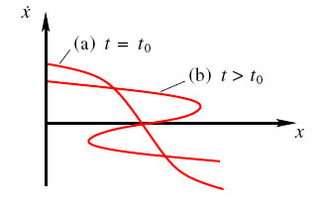August 15, 2006 feature
Scientists explain causes of abrupt rain storms

No two rain storms are alike. Dark clouds may form slowly throughout the day before a drop of rain falls, and sunny days can suddenly transform into thunderstorms. Different societies throughout history have held their own explanations for the behavior of weather – from human rituals to godly intervention – and now physicists from the U.K. and Sweden tackle one of the weirder weather phenomena: the abrupt rainfall often observed from cumulus clouds.
Michael Wilkinson, Bernhard Mehlig and Vlad Bezuglyy explain how quick showers can result from a dramatic increase in the collision rate of microscopic water droplets when the turbulence intensity in the atmosphere exceeds a threshold. Their theory, published in a recent issue of Physical Review Letters, suggests that the collision rate suddenly increases when the velocity of the water droplets as a function of position forms “caustics,” becoming a multi-valued function. When particles at the same position are moving with different velocities, the probability for collision is greatly enhanced.
“Our theory explains how turbulence can help to initiate rainfall,” Michael Wilkinson told PhysOrg.com. “It is relevant to any type of rainfall from cumulus clouds, i.e. the ‘cauliflower’-like clouds that indicate that the atmosphere is undergoing convection.”
Cumulus clouds, which develop vertically due to a convecting atmosphere, can create turbulence because convection transfers heat through circulation. This turbulence can generate the initial energy needed for moisture droplets to coalesce into full-fledged raindrops. (In contrast, stratiform clouds – which develop in horizontal layers – form in a stable atmosphere, and therefore do not elicit immediate wet forecasts.)

In the past, scientists thought that a significant cause of the increased droplet collisions was the particles clustering together in localized regions. Wilkinson and his colleagues found that, although clustering may exist in turbulent atmospheres, it does not greatly influence the collision rate, for a couple reasons. The team discovered that the collision rate remains high even when the clustering effect weakens at high turbulence intensity, and also that clustering requires a higher density than that of the particles in cumulus cloud formations.
Instead, the scientists based their theory off other data captured from previous experiments – namely, that the dramatic increase in the collision rate of droplets occurs when the intensity of air turbulence exceeds a certain threshold, forming caustics.
“The term ‘caustic’ originally comes from the burning effect of focused sunlight,” said Wilkinson. “Later, caustics were bright lines caused by partial focusing of light, often observed on the bottom of a swimming pool when ripples on the surface focus sunlight. More recently, the term has been used for other effects in particle or ray motion that are associated with the graph of a function developing a fold, so that the function becomes multi-valued. In our model, the caustics are points where the graph of water droplet velocity as a function of position folds over (see figure).”
At these multi-valued points, the collision rate jumps so quickly that Wilkinson and his colleagues can explain how rainfall can occur in just a few minutes from the onset of the clouds.
“Although there are no implications for weather forecasting etc., particle collisions in a turbulent gas must have played a role in the formation of planets,” said Wilkinson. “We want to see whether the collisions in our theory have any application in planet formation.”
Citation: Wilkinson, Michael, Mehlig, Bernhard, and Bezuglyy, Vlad. “Caustic Activation of Rain Showers.” Physical Review Letters. 97, 048501 (2006).
By Lisa Zyga, Copyright 2006 PhysOrg.com




















